State Historical Society of Iowa
Nearly every week, a mystery is solved or some interesting twig (or nut) appears somewhere on the family tree. Here is a little news of recent findings.
Making the Trip
On Thursday, I got to spend the day in one of my favorite places – a genealogy research center! As I recommended awhile back when I visited the Minnesota History Center Gale Family Library, I did some preparation before I went. I don’t know that I ever really felt totally ready, but I was armed with a list of things that I wanted to find regarding some of my Iowa relatives.
The State Historical Society of Iowa Research Library is a bit of a hike from my home. Luckily, I have a friend who is also a bit passionate about genealogy and has Iowa roots. Especially lucky for me, she likes to drive a lot more than I do, so I drove the first hour to her home and then got to be the passenger for the remaining hours of the trip. Nice! The facility was easy to find (though we did have a little trouble finding a door into the building since there was a little sidewalk construction going on). Parking was across the street from the library and was FREE! We stowed purses in lockers (two quarters required, but refunded, so again FREE), grabbed our notes, quarters, and pencils (no pens allowed) and headed into the research room.
Helpful Staff and Substantial Collection
A receptionist got us checked in and then we got a brief orientation from a helpful woman who ended up being cheery and attentive throughout the whole day. As usual, we found that staff were happy to answer questions, to point us in the right directions, and to assist with using those pesky microfilm reading machines.
The research library had a good collection of Iowa county records including vital and probate records. They also had a large collection of Iowa newspapers. All of these were on microfilm. They also had a large collection of books. One section contained books with information about Iowa and its counties and another included books covering a wide range of other history topics. Additionally, they had materials that could be ordered up from the basement storage, though they only do those retrievals on a fixed schedule a few times each day.
We are so lucky to have this facility at our disposal. There are renovation proposals being made for the building. It is a little concerning that the plans would be to demolish part of the building, reducing the size by about half. The empty space would be replaced by green space and the mission of the venue would change so that “…the new facility would also serve as a welcome center for the state Capitol. Museum space would be cut in half… ” I’m not an Iowa resident, so I don’t get an opinion, but I sure hope that they listen to the Iowa historians that are calling for the mission to remain focused on the collections and history rather than focusing on using the building as an events center for weddings and such. By the way, they already use the building for events. When we were there they were setting up for a gala. I really hope the archives continue to be available so that I can access them when I visit again someday.
Disappointments
Though I have made several attempts through the years to find birth records for Lona Iona Fawcett and Thomas Leland Estes, I still didn’t find any. A year or so ago, I paid good money to the state of Iowa to do a statewide search for those records and the results came back that nothing existed. I guess I should have believed them. In the case of Tom, who was born in 1896, the records for Monona County, his county of birth, started in 1897. Rats! Why Lona wasn’t in the list of birth records, is more confusing. Records for 1902 for Sac County were right there on microfilm, but no Lona. Actually, there were very few entries for 1902. Lots for the year before and the years after, but not for 1902. So, I came away disappointed.
I had similarly bad luck finding death records. Next time, I guess I’ll allocate my time to searching different types of records.
Good Finds
Even though I didn’t have luck with vital records, I still came away from the center with a few treasures.
Barbara Meyer and Harry Fawcett’s Marriage Certificate
It was only recently that I found the date of Barbara and Harry Fawcett‘s marriage when I found a newspaper clipping that gave the date. But now, I have a copy of the actual marriage license. It’s a nice thing to add to my collection.
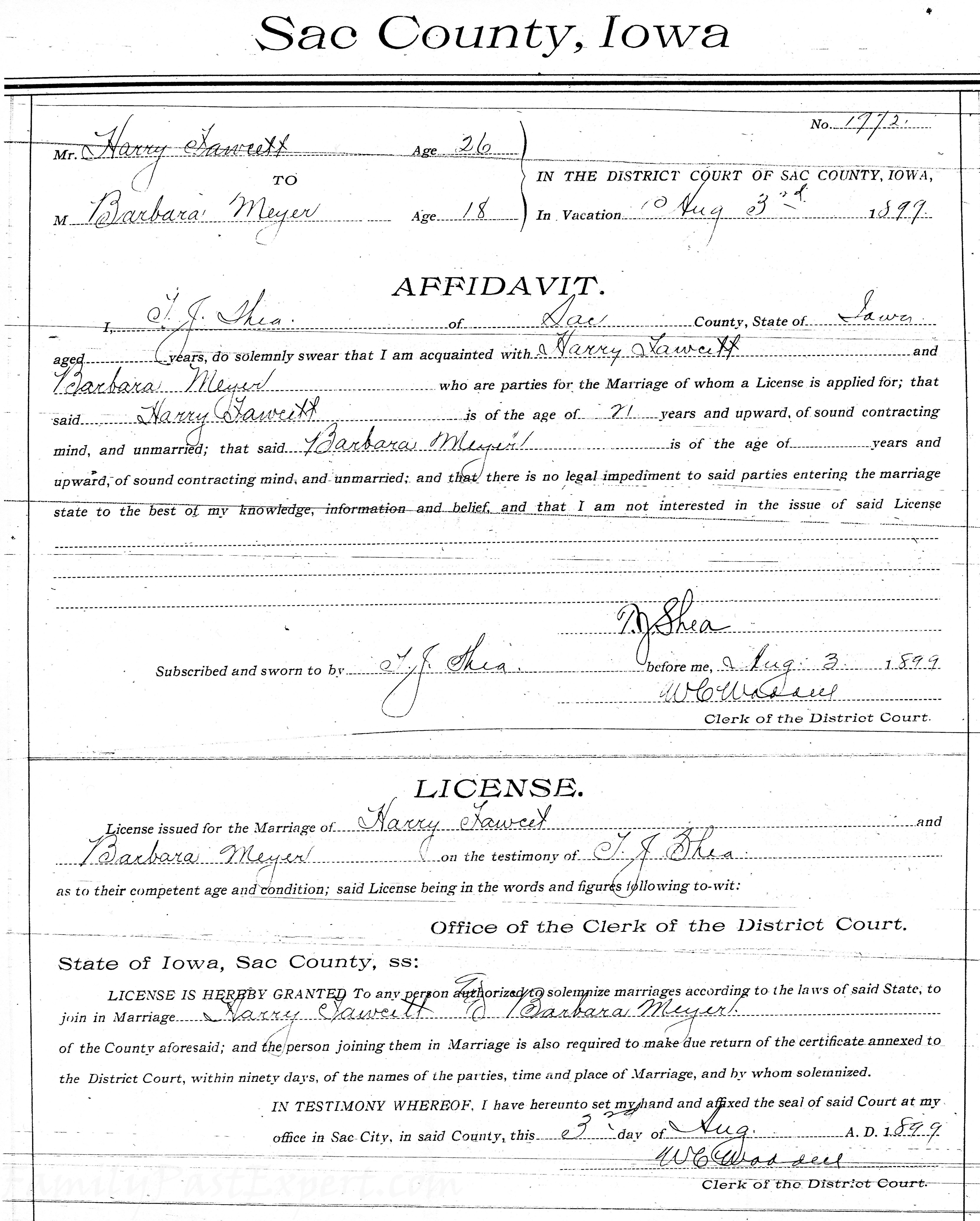
Jacob Meyer’s Will
Jacob Meyer died fairly young, leaving a farm and large family for his widow, Barbara Stadler Meyer, to manage. I was a bit surprised to find that he actually left a will. He knew that his health was failing, so he wrote his will on 10 January 1887. He then died a few months later, on 7 May 1887, at the age of 50.
The will was very straightforward. It asked that his expenses be paid and then gave his property to his wife.
“I give, devise, and bequeath to my beloved wife Barbara Meyer all my household furniture and all personal property whatsoever I may have, including horses, cattle and hogs and all other personal effects after paying all my just debts. I also give to her the use, improvement and income of my land one hundred and sixty acres in Sac County, Iowa, being the northwest quarter of Section 28, Township No. 87, north of Range 38 to have and to hold the same to her during her natural life then to be equally divided among my children.”
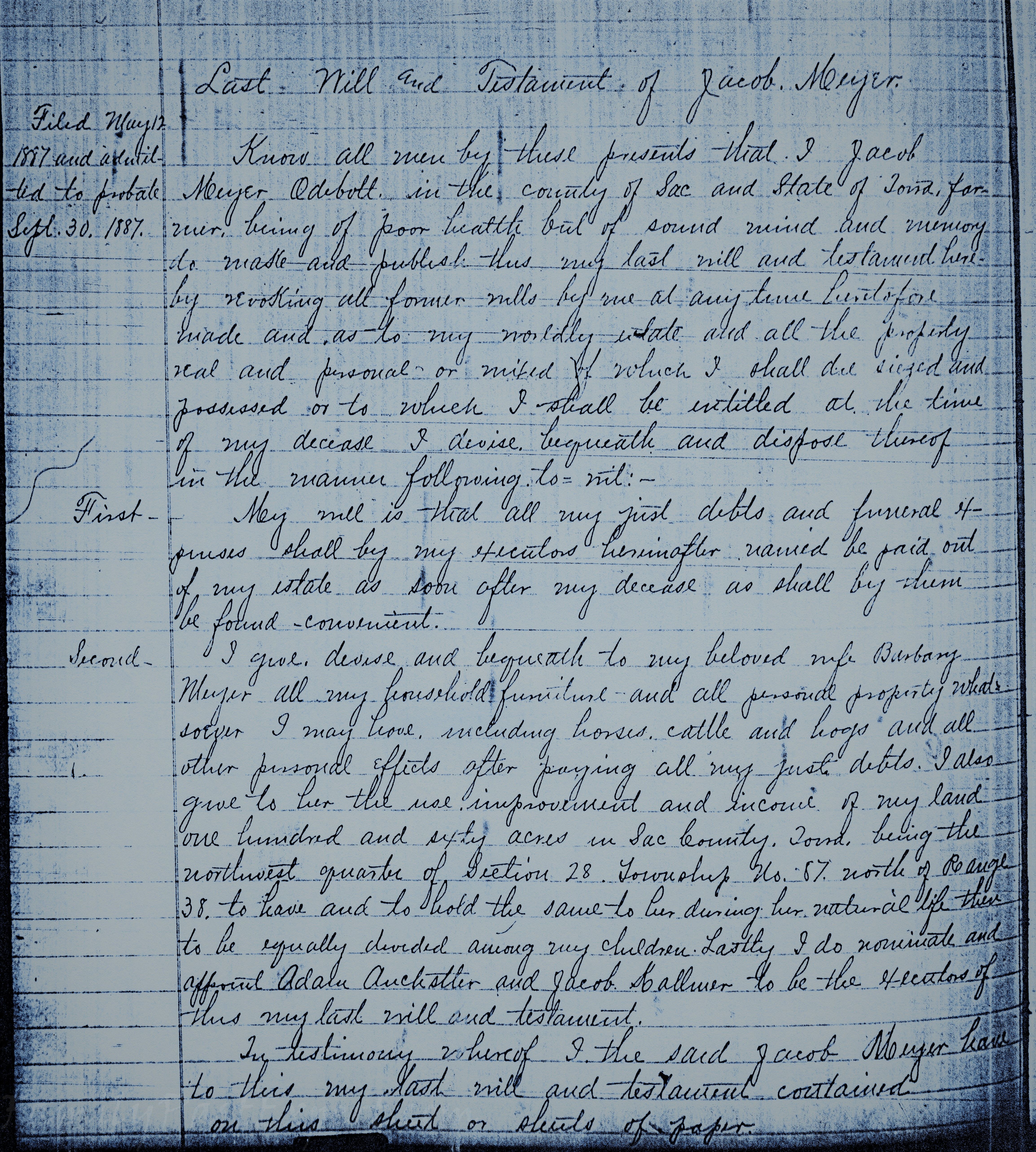

One of the most interesting things that Jacob provided us via his will was a description of the location of his farm. The following image is a snippet of a plat map, showing the location. The map is from 1930, long after the Meyer family had moved from the farm, but it lets us see where the land was in relation to the town of Odebolt.
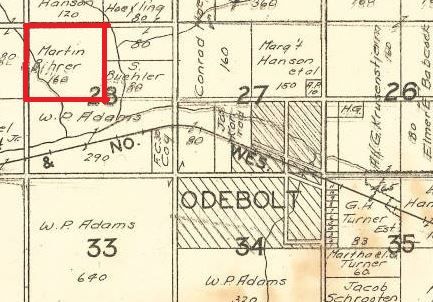
Barbara Stadler Meyer’s Estate Settlement
Barbara, Jacob’s widow, successfully managed the farm that he left to her. So, when she died, she left a will to divide the estate among her children. Barbara’s will was the very first will of an ancestor that I ever found. Back in 1995, I spent a few hours at this same library and came away elated to have found Barbara’s will and some other great pieces of information.
Boy, was that a long time ago! My kids were just little boys back then and now they are grown men. Wow!
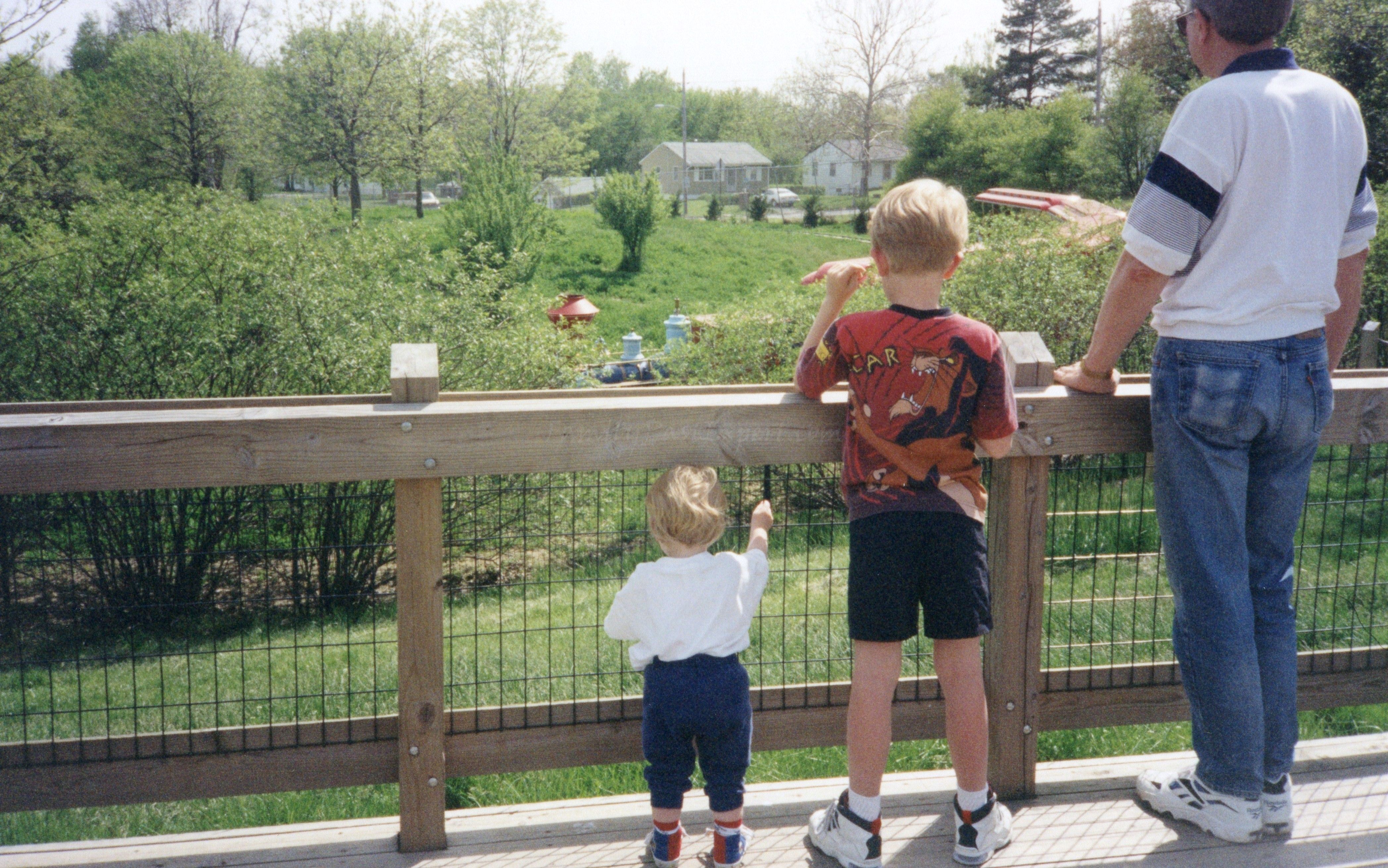
Anyway, back to the library… I’ve had Barbara’s will for decades. I had questions when I first read it because she didn’t seem to leave my great-grandma as much as she left her other children. Her sons Adam and Hieronymous got $150 plus $50 per year until each “attains his majority” (turned 21), and Barbara, our ancestor, got $50. Then, whatever was left of the estate was to be divided evenly between her children Jacob, Frank, Mathias, Robert, Christina, Katharina, Adam, and Hieronymous (but not Barbara). I felt bad for Barbara and wondered why she was being slighted.
But, on this trip, I found documentation of the distribution of the estate. It turns out that Barbara actually came out better than a lot of her siblings. She got her $50. And her brothers Adam and Hieronymous each got their extra $150. But when all was said and done, there was only $126.90 left to be divided among the eight siblings who were to share in the remainder of the estate. So, Frank, Christina, Catherina, Robert, Mathias, and Jacob only ended up receiving $15.86 each.

Tom Estes’ WWI Bonus Application
A couple weeks back, I learned a little bit about my grandpa Thomas Leland Estes’ time serving in World War I. At the research center, I found out a little bit more. I ordered down to the “basement” for his Application for Bonus. After World War I, many states authorized relief assistance payments, called bonuses, for people who served in the military during World War I. These bonuses were managed at the state level and soldiers needed to apply to the state they lived in when they entered the service.
So, while Tom had moved to Minnesota already at the time the bonuses were made available, he applied in Iowa. So, his application was in the archives there. The application was approved and it looks like he got paid $165. The application confirms things we already knew, like that he was honorably discharged and that he was born in Castana, Iowa. But, it also provides a few other tidbits of information such as that he reported for duty at Onawa, Iowa, before being sent to Camp Gordon in Georgia and that he was discharged at Camp Dodge, Iowa. So, the army must have transported him from Newport News, Virginia, back to Camp Dodge in Iowa and then he just had to make his way home from there.
A curious note on the application says that he farmed for himself before entering the service. We thought he was working for someone else still, like it said on his draft registration card. It also asked if he voted before entering the service and he answered, “To young to vote.” That is a little sad, perhaps, that boys were sent to war without even being old enough to vote. It was also nice to see on the application that he had never been A.W.O.L.


Along with the application, Tom had to have a couple guys vouch for him to say that he had indeed resided in Iowa and really was Thomas Leland Estes. One of the witnesses was Russell McCall, one of Tom’s second cousins. The other was someone named Charles Fisher, a banker.
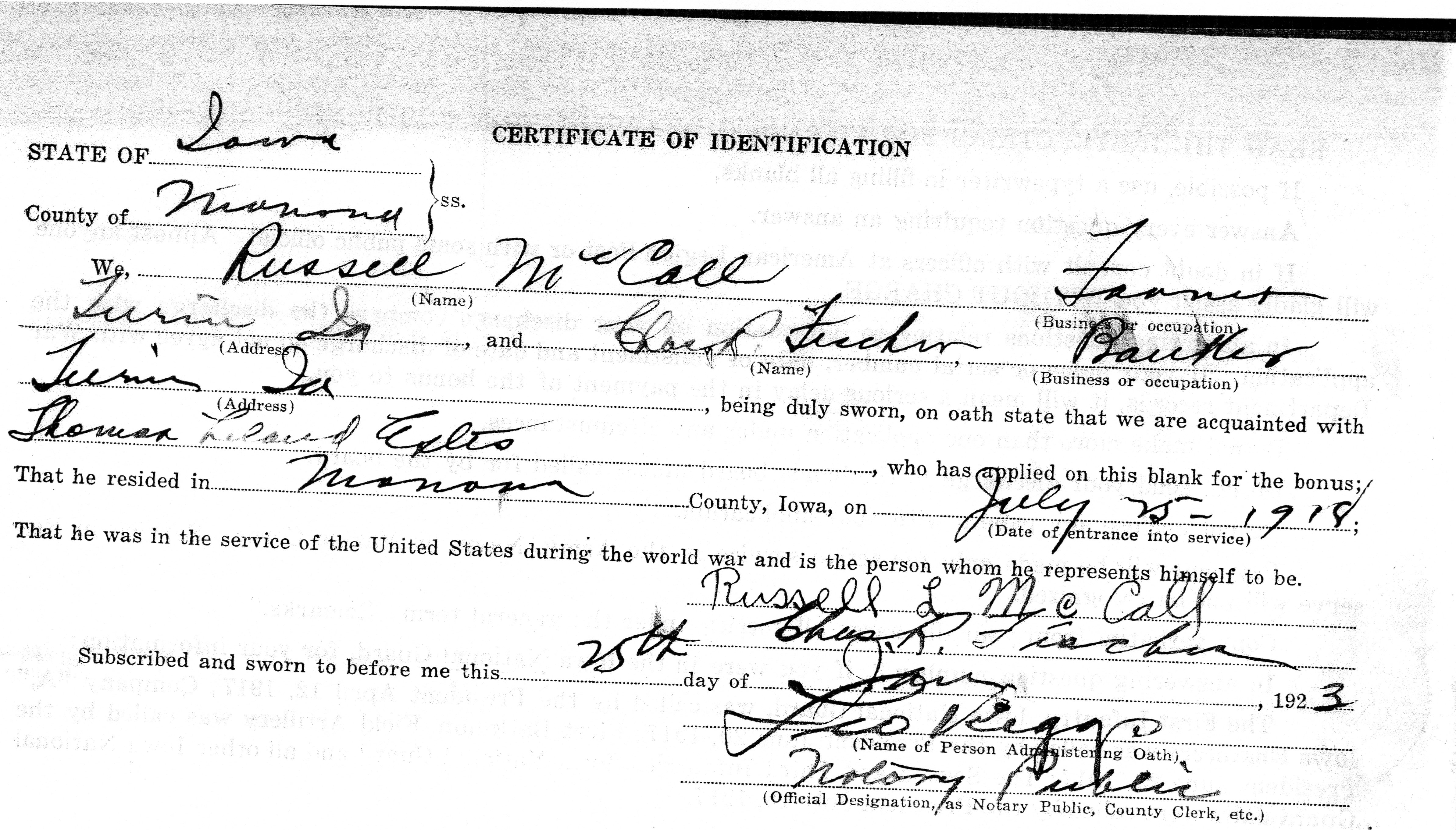
Lessons Learned
The day was productive and time well spent, but due to my years managing things in the corporate world, I always like to do some reflection and come up with some lessons learned for next time.
Quarters
I was glad to have a stack of quarters. Each print from one of the microfilm readers cost a quarter and use of a locker cost two quarters (refunded later). But, had I forgotten, I still would have been okay since they gave change at the desk.
Hunger
I should have brought a lunch and/or a snack. While there is a cafe in the the building, we didn’t think about breaking for lunch until after it had closed for the day. There were pop machines, but one was sold out and the other out of order. The staff vending machines, that the receptionist led us to, didn’t want to split out any food to us either. I did snag a chocolate bar after attempts to get a bag of Cheetos were unsuccessful, but that really wasn’t a very good lunch. No food or drink are allowed in the research center but, next time I’ll bring something to stash in my locker for break time.
General Research
Ever so often, when researching a family from home, I’ve been referred to a book that might be helpful, but that isn’t available online. I wish I’d remembered that libraries such as this have copies of those books available. Before my next trip, I need to remember to look at my list of books I need to find so that I could do some research, in this case, not necessarily Iowa research, via those books.
Research Log
While I was frantically searching for things, I made myself cryptic notes in a notebook. I know better. I need to be more organized, so that I can make sure to accurately document the sources of my information. In hindsight, I’ve decided that I should have made myself some sort of research log form that I could fill out while I was in the heat of my searches. I came up with the following form that I’m going to use next time.

Many thanks to Jodi for bringing me along on this trip. It was a great day and I am most appreciative!


Leave a Reply